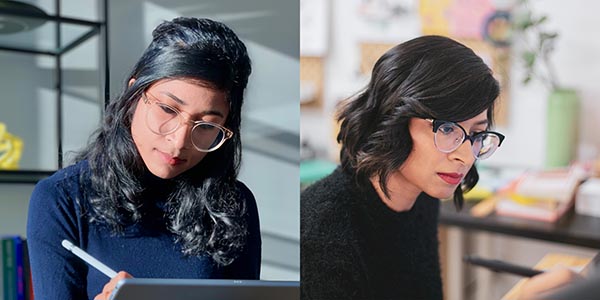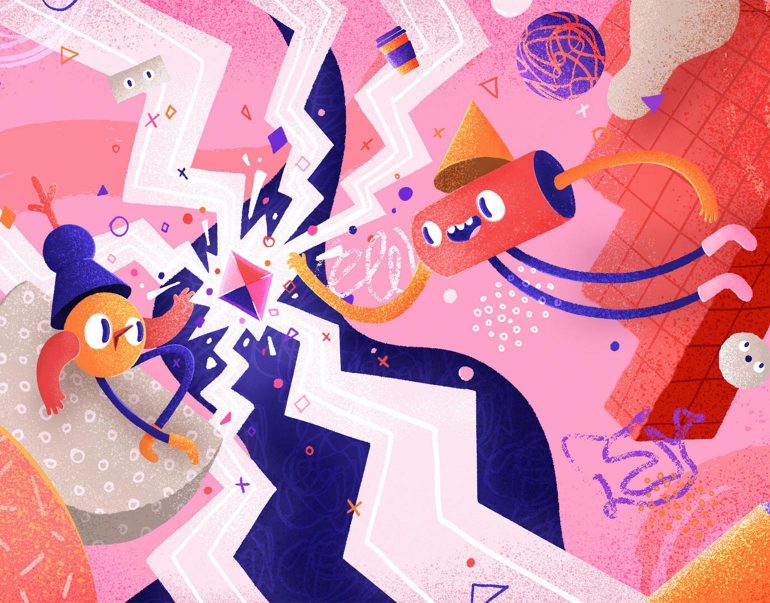A design and animation studio, Supernova Design, founded by sisters Asavari Kumar and Shaivalini Kumar has been creating refreshing, playful and thoughtful work for their clients, which include some of the best brands in the world. The studio’s work is rooted in deep research and practice that comes from the founders’ love for design and dedication towards their craft. Both the founders are devoted to create a rich body of personal work that satiates their creative hunger and responds to the contemporary issues of the world. A recent example is an animation film, Passage, by Asavari that responded to the rising negativity against the immigrants. The film collected bagful of awards and appreciation at major film festivals around the world.
We talked to the inspiring sisters about their work, inspirations and the remarkable design studio they set up. Edited excerpts below:
How and when did you decide to be designers and visual artists?
AK : I grew up on a healthy diet of stories by Roald Dahl, Ruskin bond, Salman Rushdie and Hergé with a smattering of Indian folk tales and heavy doses of Cartoon Network and Nickelodeon. This early childhood obsession with storytelling set the stage for me to pursue a diploma in animation film design from NID, Ahmedabad. After a short stint working in Broadcast & Advertising in Mumbai (Disney, VH1, Channel V); the desire to tell my own stories and develop my artistic voice led me to California Institute of the Arts, to pursue an MFA in experimental animation. Straddling the line between art, design and animation, my influences are an eclectic mix. I’ve been deeply inspired by the work of Hayao Miyazaki, Eyvind Earle, Yayoi Kusama and Bridget Riley to name a few.
SK : I was always inclined toward arts and crafts as a child, and as I grew older, I gravitated to illustration, lettering, and contemporary and urban art. The culture, dialect and surroundings of my childhood in New Delhi, India, strongly influenced my aesthetic style. Since graphic design is an all-encompassing discipline, I decided to pursue a BFA to understand visual communication more clearly. My design features an amalgamation of cultural imagery and new-age design techniques. While studying design I was influenced by the works of Helen Dardik, Mari Mekko, Jessica Heische and many more.

What led to your decision to set up your own design studio, Supernova Design?
AK + SK : Supernova Design was founded because we wanted to be a part of something bigger than our individual selves. It was important for us to retain our autonomy as artists and designers and engage with the creative field on our own terms. We set up Supernova in 2015 and have been creative partners on personal and commercial projects ever since. Earlier this year we were joined by Siddharth Zutshi who has taken over business development and marketing for Supernova.
Our challenges have primarily been logistical because we both moved to two different countries to pursue our individual careers. Over the past few years, Supernova has also been a process of trying to build something that transcends geographical boundaries and limitations. We started out doing personal projects. Our very first undertaking was a branding exercise for Supernova. We tried to give some shape and form to the larger brand voice that represented our values and ideologies.


There is a distinct signature touch in all the works created at Supernova. Is the signature touch an extension of your creative personalies or is it acquired after careful exploration?
SK: Our style stems from our early influences, personality and also core values. Over the years our style has definitely evolved, as we moved through our own individual and collective journeys as designers.
AK: As sisters we have a lot of personal and artistic overlaps so the signature touch you see in the work today has evolved organically over time. The longer we work together, the more we are able to achieve harmony in our process. That being said, there is a wide range of approaches we work with to honour each other’s individuality within the larger visual paradigm of our work.
Is it challenging to maintain the style across all works, including client work?
AK + SK : The word ‘style’ feels reductive particularly because there is a lot of visual variance in our work. What we try to keep consistent across projects is our creative voice and point of view. For each project, commercial or personal, a visual language is developed to serve as a vehicle for its underlying message. As artists we certainly gravitate towards certain aesthetics but as designers we try to serve the needs and demands of the creative brief and let our intuition guide us.
How do you divide time and resources between personal and professional projects?
AK + SK : Personal projects have not only been a means for us to express ourselves and find our voice, but have also been essential in helping us build our community. We always try to strike a balance between the time and resources dedicated to personal work and client work as each of those things have a role to play in our overall growth. In terms of personal projects, we typically create work anywhere in the spectrum of making short illustrated stories all the way to producing short films. We try to make sure that we create a certain amount of personal work each year, as client work for us is something that is always ongoing, and is necessary for our business.
A New Normal, a film where everyday digital conversations with a family are overlaid with AR versions of the family members to co-create a mixed reality experience
What possibilities is AR bringing to storytelling? And for those who want to start today, what is the best place?
AK + SK : With the rise of divisive discourse at a global scale, the notions of home and identity are called into question more than ever. When access and mobility become points of contention, AR can be a powerful medium to tell compelling personal stories by placing people and characters in spaces they may not otherwise inhabit. During this pandemic, we’ve seen an increased demand for connection and empathy as well as a need to re-examine limited physical spaces in new and interesting ways. For those looking to start dipping their toes into AR, Adobe Aero is a good tool to begin with.
***

